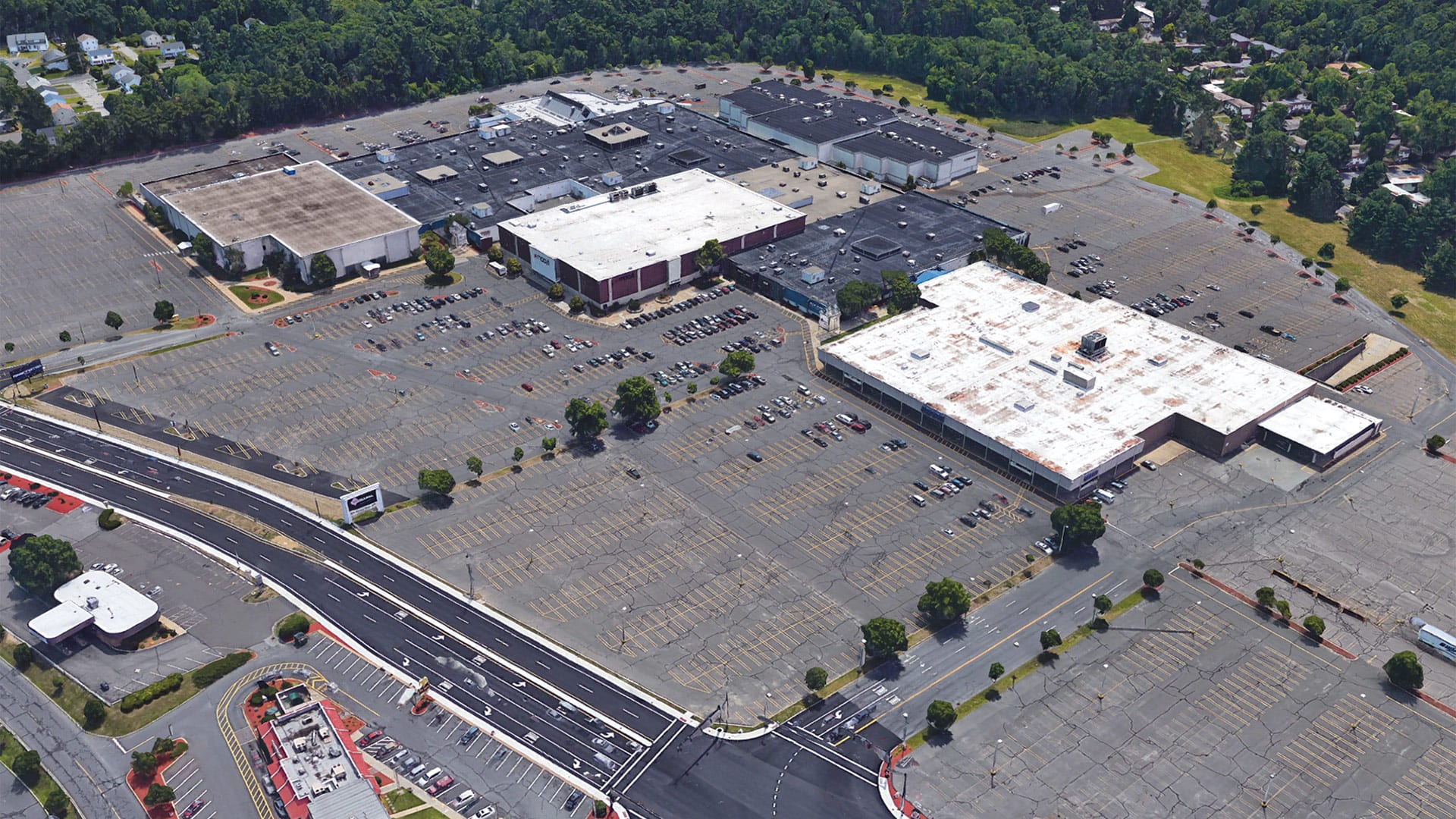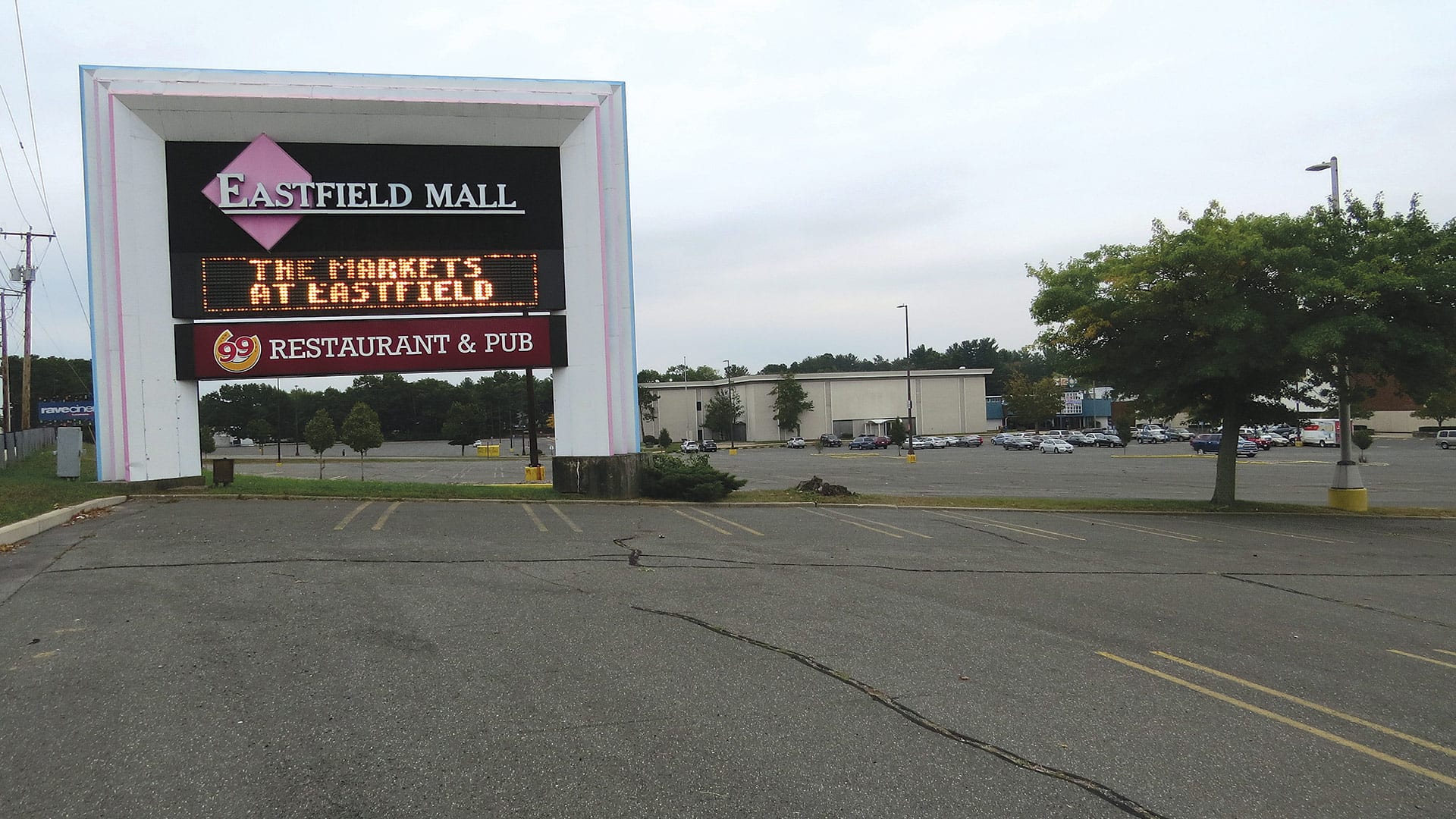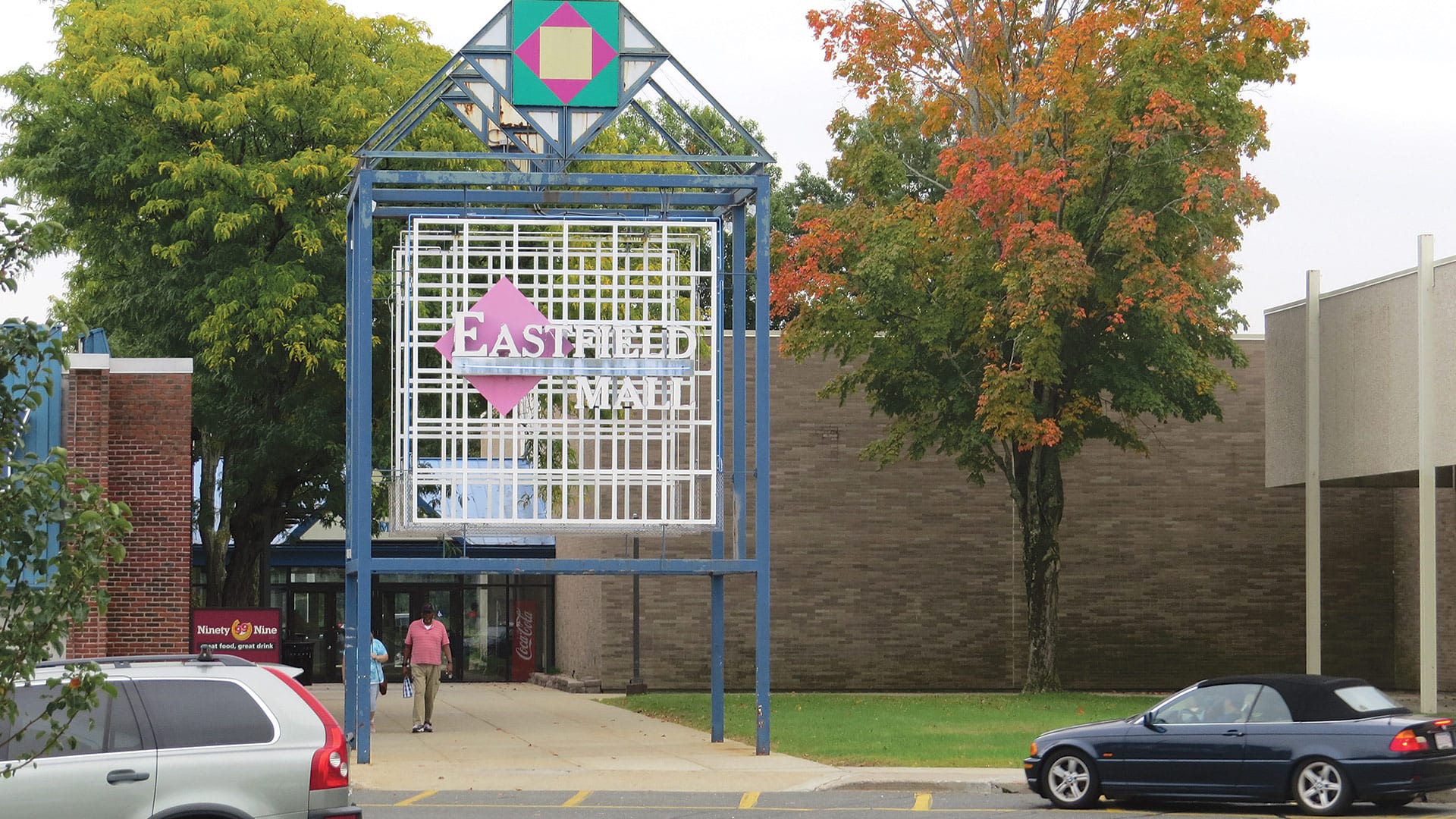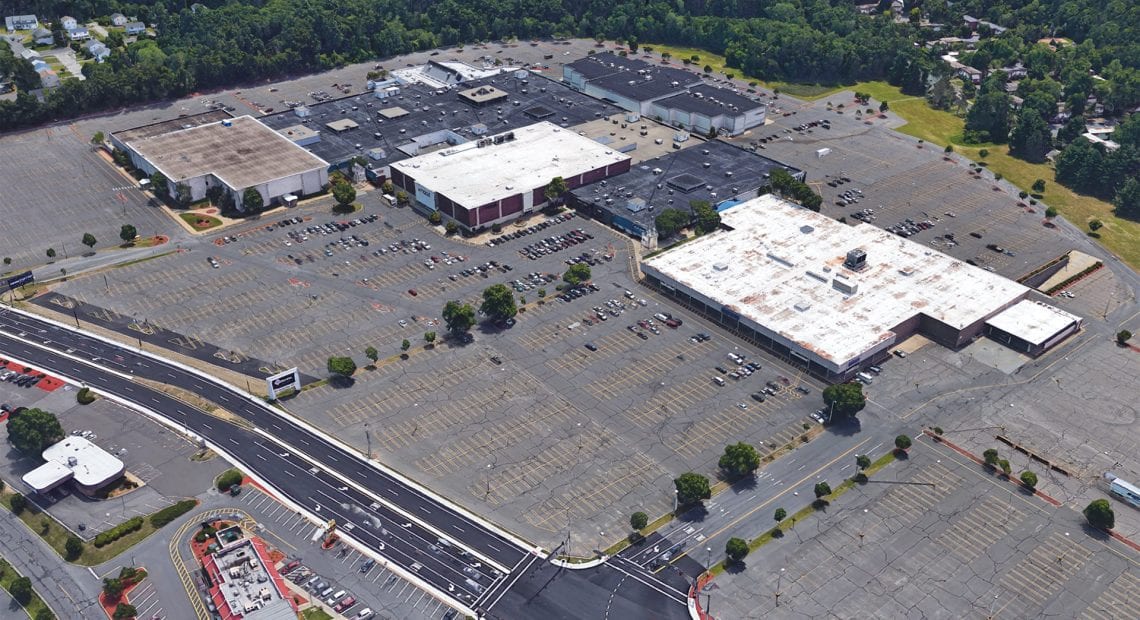Thinking Outside the Big Box

This Google Earth image of the Eastfield Mall shows how, with the closing of its main anchors, its vast parking lots are almost empty.
The emergence of online shopping giants like Amazon and changing shopping patterns have spelled doom for giant retailers while also hastening the demise of indoor shopping malls across the country. The Eastfield Mall in Springfield is part of this trend, and so is the ambitious plan for its next life — as a so-called ‘community within a community.’
Chuck Breidenbach says the term ‘de-malling’ — or the verb ‘de-mall’ — while still not officially in the dictionary, has been part of the business lexicon for quite some time now.
That’s because, ever since they started building large, enclosed shopping malls more than 50 years ago, some have occasionally failed and had to be repurposed. This region has witnessed the phenomenon a few times, starting with the so-called ‘dead mall’ in Hadley, which went silent more than 30 years ago, and the Fairfield Mall in Chicopee, which succumbed at the start of this century.
But the pace of de-malling has picked up in recent years, as everyone knows, thanks to Amazon and other online retailers, as well as changing shopping habits, especially among the younger generations. And with those trends, old shopping malls have found new lives as everything from homeless shelters to apartment complexes to mixed-use facilities blending residential, retail, and entertainment elements.
Which brings us to the Eastfield Mall in Springfield, near the border with Wilbraham. The facility is historic, sort of, because it is the first enclosed mall in the region, opened in the mid-’60s. But it is also typical of recent trends, because most all of its big box stores — Sears, JCPenney, and Macy’s — have closed, leaving hundreds of thousands of square feet of vacant retail space looking for a new purpose.
Finding one has been Breidenbach’s day job (or one of them) for some time now, in his role as managing director of MDC Retail Properties Group, a division of New Jersey-based Mountain Development Group, which has owned the mall since 1998.
Mountain Development recently hired the real-estate brokerage firm Cushman and Wakefield to market a joint-venture partnership opportunity for the property’s mixed-use development. The solution taking shape on the drawing board — a work in progress, to be sure — is called Eastfield Commons, a $200 million, mixed-use development that Breidenbach likes to call a “community within a community.”
That’s because it will be just that, a community, a place where — theoretically, but also realistically — if all goes as planned, someone can live, work, shop, eat, take their children to daycare, go to the gym, see a movie, and more, all while walking a few hundred yards at most.
“You want to develop this as a tightly knit, walkable community,” he explained, adding that just what shape this community will take remains to be seen.
At many converted malls, the inclination is to go vertical, with multi-story developments. But at Eastfield, the tact may well be to go horizontal, with one or two levels.
The concept plan taking shape (see rendering on page 8) calls for 450,000 to 500,000 square feet of commercial space (remodeled and new construction) and 23 residential buildings with 12 units each (276 total units). The cinemas will remain, as will the existing food court.
“The idea is to open it up and take it from an enclosed mall to an open-air concept with a lot of public space, a lot of green space … very much the opposite of what you get in an enclosed mall,” he said, adding that this has been the trend nationally, by and large.

“Our vision is to put in a number of restaurants of different types and price points so people have their choice,” he went on. “And to also have some specialty retail, a mix of national and local, so we can give this center its own local flair.”
Flair of any kind has been a missing ingredient at the sprawling site off Boston Road, but as the art and science of mall conversion continues to mature — and Springfield continues its economic recovery — there is considerable optimism that Eastfield can do what it did 50 years ago and get the region buzzing about something new and different.
“The idea is to open it up and take it from an enclosed mall to an open-air concept with a lot of public space, a lot of green space … very much the opposite of what you get in an enclosed mall.”
For this issue, BusinessWest talked at length with Breidenbach about mall redevelopment in general, and repurposing Eastfield in particular. He noted that, with these projects, the market will dictate what can be done, but imaginative, outside-the-box — or in this case, outside-the-big-box — thinking is always needed.
Setting Sale
Breidenbach has had a long career in retail — long enough to have seen malls come to what amounts to full circle, meaning from being in demand to being in serious decline.
“I’ve seen a lot of things come and go; I’ve lived through the golden years of shopping centers, when you couldn’t put them up fast enough,” he told BusinessWest. “And now, we’re in the gray years of shopping centers, where you can’t redevelop or convert them into something else fast enough.”
The latest cycle — of conversion, or de-malling — began early in this century, he went on, adding that, as was noted earlier, Fairfield Mall, now the site of a Home Depot and other retail outlets, was part of that early wave.
But the pace of conversion really picked up roughly a decade ago, he said, as the Great Recession, coupled with the emergence of online retailers and some changing shopping patterns, took a huge toll on traditional retailers, a trend that continues today.
“There was a change in generations,” he explained. “The Baby Boom generation was and still is, in many ways, a very shopping-oriented culture. The Millennials and Generation-X folks are not.”
Some facilities — Breidenbach calls them super-regional malls, or fortress malls (the Holyoke Mall is one of them) — have been more resilient to the forces of change, because of sheer volume of stores, location (the Holyoke Mall certainly has that), and other factors.
“Holyoke has multiple levels, multiple anchors, parking decks … it’s made to do a massive amount of business,” he explained. “And retailers have pulled back into those fortress malls really as a means of protection.”
Meanwhile, those same retailers are leaving smaller facilities such as Eastfield, he went on, adding that the handwriting was pretty much on the wall for many of these malls years ago. And major real-estate companies, such as the Rouse Co., which developed and owned Eastfield for many years, saw that handwriting and sold off many of those properties.
Today, Eastfield’s huge parking lots fronting Boston Road are barren wastelands. Cars, and not many of them, are clustered near one of the main entrances where a few retailers still do business, such as Old Navy, the 99 Restaurant, O’Donnell’s Restaurant, and others.
Changing this landscape is an involved process, said Breidenbach, adding that, when it comes to how malls are converted these days, it’s generally a function of what the market in question wants, needs, and will support. In other words, while there are models that be studied and perhaps borrowed from, each property is unique, and so is its conversion.

Opened in 1967, Eastfield was the region’s first enclosed mall. Today, it is part of an ongoing trend that is seeing these facilities put to new and imaginative uses.
“Your market studies will lead you to specific strategies and different amounts of space devoted to different types of uses,” he explained. “Those studies will determine how much you need for multi-family rental, multi-family condominium-style properties, retail uses, restaurant uses, entertainment uses, personal services, medical uses, health and fitness — it all depends on what the market will bear, what’s missing in the area, and what people are leaving the area to try and find because they’re dissatisfied with what they get, or it’s not being supplied.
“We have to follow the numbers very closely,” he went on, adding that market studies are followed up with surveys of various constituencies (including residents, small-business owners, and restaurateurs) in the area in question asking people what they want to see and what they’ll come to that location for.
At Eastfield, the emerging solution is a what Breidenbach calls a ‘live, work, play’ atmosphere, one that is seemingly internet-resistant.

This rendering shows the proposed components of Eastfield Commons.
In other words, one can’t live on the internet, or eat a meal there, or have their haircut there, or take dance lessons there.
And that’s the general idea as one goes about repurposing a mall, he went on, adding that the goal is to create a destination that will hopefully appeal to all generations, but especially those who seem to like this model — empty-nesters and the younger audiences that are less inclined to shop than their parents or grandparents.
“These younger generations would much rather pay for an experience than an expensive pair of jeans,” said Breidenbach, adding that ‘experience’ is a broad term that covers everything from a movie to a meal out to laser tag.
And these sentiments are reflected in some of the statistics relayed to attendees at the latest Shopping Center Convention in Las Vegas, a massive gathering Breidenbach has attended religiously for decades now.
“We heard that restaurant sales in the U.S. had surpassed grocery stores for the first time in history,” he said. “That means more people are eating out — they’re spending their time and money in that direction, as opposed to eating at home and then buying things.”
The Shopping Center Convention, staged annually in May, has seen discussion gravitate in recent years toward the internet and, more specifically, how to survive it, with a big focus being on just what to do with traditional malls, like Eastfield, that have been marginalized (Breidenbach’s word) by the fortress malls and online shopping.
Mixed-use developments — vertical and horizontal alike — have become the answer in many cases, with individual components varying, as stated earlier, with identified need and demand.
Breidenbach believes there will be a need for housing at that site, particularly the multi-family variety, because there haven’t been any new developments of that type in that area in decades, and there is apparent need for such a product.
“We see a huge a huge opportunity there for up-do-date multi-family housing,” he told BusinessWest. “And we also see a need for up-to-date, current retail space, meaning junior anchors, stores up to 20,000 to 25,000 square feet; this is an opportunity to think differently.”
Registering Results
Or to think outside the box — the big box, he said in conclusion.
Such thinking is necessary at Eastfield, a once-vibrant shopping area that has become part of an ongoing trend in this country — one that is seeing the enclosed shopping mall turned into a relative ghost town.
Now, Eastfield wants to be part of another trend — bringing new life to these deserted or nearly deserted areas.
If things go as planned, a property that made some history a half-century ago can make some more.
George O’Brien can be reached at [email protected]










